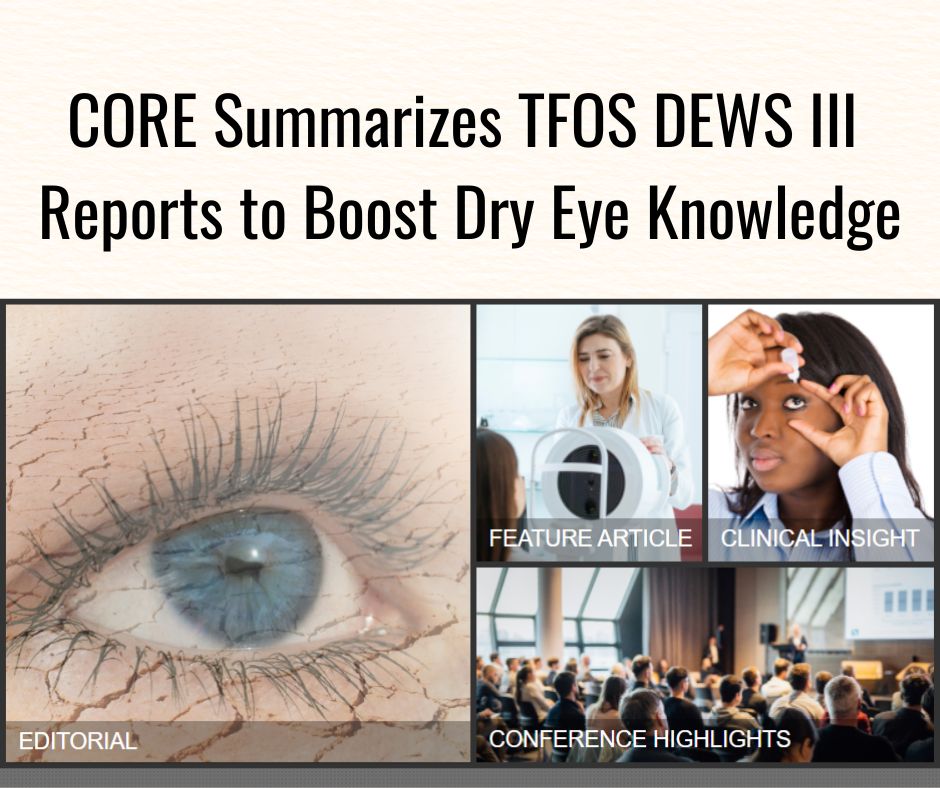CORE Publication Helps Eye Care Professionals Prepare for a New Wave of Dry Eye Disease Medications
.jpg)
WATERLOO, Ontario, In response to accelerating clinical interest about new, innovative treatments for dry eye disease, the Centre for Ocular Research & Education (CORE) has dedicated Issue 77 of Contact Lens Update to several recent introductions and promising pipeline developments. The publication is available at no charge by visiting ContactLensUpdate.com.
“Dry eye disease affects millions of people across the world and can have a significant impact on their lives. Our growing understanding of this complex condition has led to the development of multiple new medications—both approved for sale and undergoing trials—that we believe have important clinical potential,” said Alex Hui, Head of Biosciences at CORE.
“In primary eye care settings, dry eye is encountered daily. These additional treatments, targeting different aspects of the disease, will offer practitioners more options to incorporate into their prescribing arsenal and help patients better manage the condition.”
Hui, who is also an adjunct associate professor at the School of Optometry and Vision Science, UNSW Sydney, shares his expertise in the issue’s editorial. His overview covers recently approved treatments such as a short-term corticosteroid to treat acute periods of worsened dry eye, a preservative-free ophthalmic solution that slows tear evaporation, and investigational products that either target inflammation or stimulate receptors on the ocular surface to increase the production of tears.
The feature article is authored by Etty Bitton, a professor and director of the Externship Program and Dry Eye Clinic, School of Optometry, University of Montreal. She summarizes the findings of a systematic review and meta-analysis that investigated the efficacy and safety of a novel nasal spray to manage dry eye. Her article provides an overview of how different doses can impact signs of dry eye and reviews observed ocular and non-ocular adverse events.
Quillan M. Austria, an ophthalmology resident at Weill Cornell Medical Center, New York Presbyterian Hospital, and Christopher Starr, an associate professor of ophthalmology and director of ophthalmic education at Weill Cornell Medical Center, co-author the issue’s clinical insight column. The case report details a patient’s experience with dry eye and management with a recently approved ophthalmic solution to treat Demodex blepharitis.
The conference highlight is contributed by Alison Ng, a Lead Clinical Scientist at CORE, University of Waterloo. The abstract summarizes a presentation from the American Academy of Optometry 2023 annual meeting, detailing a phase two clinical trial that investigated the use of a new topical ointment to treat meibomian gland dysfunction. The work details changes in signs and symptoms over a three-month period of use.
Published six times per year, Contact Lens Update provides a global platform for unbiased clinical insights based in current research. Since 2011, each issue has provided dependable and up-to-date ocular health information for more than 60,000 leading eye care professionals.
In addition to a complete archive of back issues, ContactLensUpdate.com offers a resource library that provides no-cost professional tools, patient resources, images and video. It also houses complimentary technical training videos produced by International Association of Contact Lens Educators, plus an industry glossary. Industry professionals can access the latest issue directly from ContactLensUpdate.com or quickly sign up for email receipt of future issues.
The publication receives support from the educational arms of Alcon, CooperVision, and Johnson & Johnson Vision.
 |

5.jpg)
4.jpg)
2.jpg)

3.jpg)
2.jpg)


1.jpg)



.jpg)
.jpg)



_(Instagram_Post).jpg)
.jpg)
_(1080_x_1080_px).jpg)


with_UP_Cabinet_Minister_Sh_Nand_Gopal_Gupta_at_OpticsFair_demonstrating_Refraction.jpg)
with_UP_Cabinet_Minister_Sh_Nand_Gopal_Gupta_at_OpticsFair_demonstrating_Refraction_(1).jpg)

.jpg)








.jpg)



.png)




